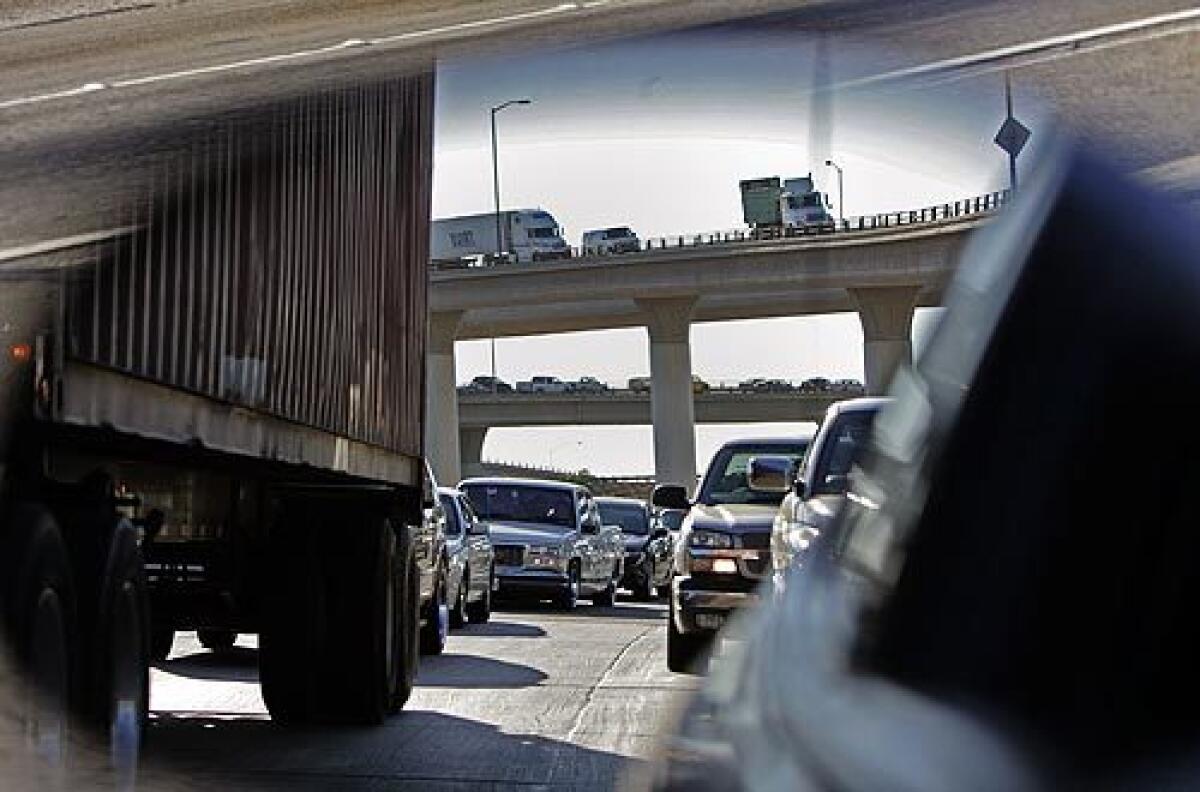How you, a Southland driver, can make my commute better

When Los Angeles traffic experts get depressed at the sorry state of the freeways, their minds sometimes drift to the improbable days of 1984, when the Olympic torch blazed through town and the city’s sea of cars parted.
For more than a week, downtown and Westside freeways worked as their creators had intended, whisking drivers from place to place.
The respite from congestion was flickeringly brief, but many still ask: Can the experiment be repeated?
For the 16-day event, transportation agencies put aside turf wars. Employees carpooled or worked staggered hours or took vacations. Truckers shifted deliveries to off-hours. Construction projects were rescheduled. Arterial lanes were reserved for buses. Two-way streets became one-way streets.
“We had essentially no congestion,” said David Roper, retired operations chief for the California Department of Transportation’s Los Angeles division. “What was behind all this was the feeling ‘I don’t want to be the guy who screws up the Olympics.’ ”
It was “a real-world example,” Roper said, “of how a few minor adjustments” can spur major improvements. Though overall traffic rose slightly, a 2% drop in the number of cars at rush hour kept traffic moving.
A similar thing happens on holidays that affect only government workers or on Jewish holidays such as Yom Kippur, when just a small percentage of drivers stay home but traffic speeds pick up nicely and rush hour lasts about half as long. And traffic has eased slightly in some places with the recent rise in gas prices.
It turns out that meager fractions, added or subtracted, can make the system scream or purr.
So if the answer to our traffic miseries seems so simple -- keeping a handful of wheels off the road -- how come it’s so hard to do permanently?
Consider what happened in 1988, when Honolulu tried to thin rush-hour traffic by forcing half the city’s public employees to arrive at work 45 minutes later for a month.
Congestion eased, but the affected workers complained of problems with ride-sharing, child care and meeting other obligations before and after work. In the end, the main beneficiaries were drivers who didn’t have to shift their schedules.
Or consider what happened that same year, when the South Coast Air Quality Management District required about 9,000 big firms in the area to find ways to reduce solo car trips. The firms promoted carpooling, sold transit passes and provided on-site health clubs, cafeterias and cash machines.
The result? More people got to work by bike, bus, carpool and on foot.
But businesses chafed at what they considered an unfunded government mandate, and complaints grew with the early-1990s recession. So the program became voluntary and withered.
People say they want less traffic, but they don’t want to be forced to alter their habits, planners say. And no one has found the key to getting them to change voluntarily.
The 1984 Olympics worked, traffic-wise, only because the changes required were temporary, according to a study by USC transportation expert Genevieve Giuliano.
As normal life reasserted itself, competing interests came back into play. Truckers had no incentive to work late without overtime. Workers wanted to return to their normal hours and ways of getting to work. Complaints by local merchants killed a pair of one-way streets linking the Coliseum to downtown, even though the shift had substantially increased flow.
Much of the time, when government declares war on congestion, it does so by laying track or pouring concrete. Lure people from their cars with improved mass transit, the thinking runs, or free up the roads by building more of them.
But despite massive investments in both strategies, Southern California traffic has worsened as newcomers have poured into the area and commutes have lengthened.
L.A. County has emphasized rail. Since 1990, 73 miles of subways and light rail lines have been opened in the county, at a cost of more than $7 billion. The system now has a mere 275,000 boardings on an average weekday. And the actual number of riders is even less, since each rider may board several trains during a single round-trip commute.
Orange County has pursued a different approach, adding 646 miles of freeway lanes -- about half of which are on privately funded toll roads -- at a cost of more than $5.7 billion. In one of the county’s largest projects, the 5 Freeway was expanded from six to 14 lanes in many places.
For all that, Los Angeles and Orange counties retain their status as two of the most congested counties in the nation. While Orange County’s ambitious building projects have improved traffic somewhat, 67% of the county’s highways are considered congested during rush hour -- the highest percentage in the region. Caltrans officials say the expanded sections of the 5 will reach capacity by 2010.
Meanwhile, Los Angeles has struggled to entice people onto its mass-transit network. In recent months, there appears to have been an increase in rail ridership in response to the surging price of gasoline. But despite the $7-billion investment in light rail and subway lines, transit agencies in L.A. County have not been able to increase their market share. Census data show that as income rises, transit use declines, suggesting that the moment people can abandon buses or rail, they do.
It’s not that new construction can’t help. Most planners see promise in building lanes to separate big rigs from other traffic and in eliminating railroad crossings at street level.
But there is an ironclad rule that helps account for traffic’s mulish persistence: When travel on the freeway becomes easier, more people do it.
“We’re not going to clear up congestion with alternatives,” Roper said, “because the thing that’s going to drive people to alternatives . . . is congestion.”
The appeal of the solo drive -- with its promise of freedom and privacy -- remains deep: Between 70% and 80% of commuters in Southern California still go it alone. The latest idea to change that is to make them pay. What if companies charged employees $35 a day for parking? What if cities created car-free zones, as in Europe? What if drivers had to pay for using overcrowded freeways such as the ones that intersect downtown?
High gasoline prices lately have eased traffic on some freeways, experts say, and spurred demand for more fuel-efficient cars.
But Rand Corp. transportation expert Martin Wachs thinks it will take more. Even if fuel hits $5 a gallon, he said, congestion will merely thin at the margins -- meaning shorter rush hours -- rather than evaporate. “I think the price at which people will stop driving is much higher,” he said.
In central London, car traffic has dropped 20% since 2003, when the city began charging motorists a fee of about $16 if they wanted to drive into the city center. And there have been other benefits: Bus ridership has surged, and the tolls paid by drivers are being used to improve public transit.
Congestion pricing “has worked around the world in about 100 different places, 100% of the time,” Wachs said.
But there is a downside: Levying tolls in crowded areas is the kind of third rail that politicians are loath to approach. The mayor of London endured calls for his ouster after he instituted central city driving fees. In Southern California, motorists tend to scream about even the suggestion of tolls on existing roads.
Brian Taylor, a transportation expert at UCLA and a prominent advocate of tolling, pointed to the success of the tollway between Anaheim and Corona, which opened in 1995.
Motorists pay tolls ranging from $1.20 during off-peak hours to $10 when traffic is heaviest to use Express Lanes on 10 miles of the 91 Freeway. Those who pony up say they save about 27 minutes on their morning commutes and 39 minutes in the evening. Transportation agency polling has found that commuters in Orange County have accepted toll roads, which makes Taylor optimistic that motorists elsewhere also will.
We’ll find out soon enough. In April, the Metropolitan Transportation Authority voted to convert some carpool lanes on the 10 and 210 freeways to toll roads. The move came after the federal government said it was prepared to offer $200 million for upgraded buses and rail lines if transportation officials would agree to institute so-called congestion pricing on some freeways.
Donald Shoup, an urban planner at UCLA, has a different idea for making commuting more expensive. He notes that 95% of people who drive to work park free when they get there, and that they would carpool more if there were a financial incentive.
“Everybody expects to park free everywhere they go, and that means that cars are the obvious way to travel,” Shoup said. Wachs, of Rand Corp., sees the problem as even more basic. For all the bitter carping, he said, motorists show more tolerance for stop-and-go conditions than for solutions that require personal pain.
“The solutions are not unknown,” Wachs said. “The fact that we are inhospitable to all of the solutions must indicate we would rather have the problem as we have it now than solve the problem.”
christopher.goffard@ latimes.com
More to Read
Sign up for Essential California
The most important California stories and recommendations in your inbox every morning.
You may occasionally receive promotional content from the Los Angeles Times.












